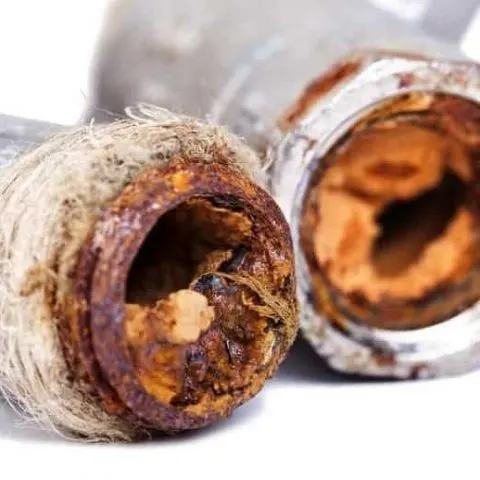If the water flowing from your taps is constantly under low pressure, it could be because of sediments in the water lines. Sediments not only clog your pipes, but they can also contaminate your water and pose a serious health risk. Cleaning out your water system from time not ensures smooth flow and helps keep your water clean and palatable.
Why Do Sediments Form in Water Lines?
-
Rust
Rusting is one of the main sources of sediments in plumbing fixtures. Usually, this is as a result of old iron pipework, but it could also be coming from your water tank. If you notice the water turning brown or orange color, it’s likely a sign of rust in the system.
The solution to this problem is to replace the pipework as soon as you notice rust. Doing an annual inspection of your pipework and tanks can help you detect early signs of any such corrosion.
-
Debris
Small particles getting into your water system can also be the source of sediment in plumbing. When this happens, most likely your tank doesn’t have a lid or it’s not fitted well. This allows for animal droppings, organic matter and other things to get in.
Make sure you take appropriate action if your lid is broken or doesn’t provide adequate protection from external contamination. An annual inspection of the tanks helps detects any such problem early on.
-
Limescale
This is a major problem if you are using hard water. If you notice limescale deposits that have built up around a tap outlet, showerhead or other plumbing fixtures, you can be certain these external indicators are a sign that something much more serious is hidden insides your pipes.
Make sure you regularly de-scale to reduce sediment and avoid having your water pipes clogged with calcium. If the cases are extreme, you could consider installing a filtration system or water softener.
How to Clean Sediments from Water Line
Cleaning the Aerators
Start by cleaning the aerator on your faucet. Sediments can easily deposit in there and it makes no sense cleaning your water lines and leaving the sediments in the aerator.
To do this:
- Put a towel in the sink to cover the drain.
- Then, use a wrench to unscrew the tip of the faucet. Wrap a small washcloth around the faucet to make it easier to unscrew if you can’t do it with your hands.
- Remove all the 3 parts of the aerator and remember how they go back in.
- Rinse the removed parts with water.
- Put everything back and screw back the aerator.
- Repeat this process with all your faucets.
Flushing the Pipes
The next step is to flushing your pipes. It is the simplest way to clean out water lines. Let your water run in full pressure for some time to see if this clears the lines.
- Open 3 or 4 cold water faucets at full force and let them run for 20 minutes.
- You should see clear water, but if you don’t, run it for 30 minutes and repeat the process.
- In addition to the indoor faucets running, you can also turn the outdoor hose at full force for 20 minutes also.
Using Acid to Flush Water Pipes
If letting your water run under full force doesn’t clear your lines, another option is to acid flush water pipes to unclog them. Muriatic acid can be very effective at unclogging pipes that don’t seem to work with the gentler solutions.
Check this too: How to Clean Glass Shower Doors
Make sure you are using the acid in a well-ventilated room. Also, put on gloves, mask and safety goggles before opening up the muriatic acid.
- Measure out one half cup of water into a glass measuring cup.
- Then, carefully add muriatic acid to the water carefully.
- Pour the diluted solution into the clogged drain and leave it for about 15 minutes.
- After the 15 minutes, turn on the cold faucet and let the water run down the drain.
- The acid should have cleared the clog by now, but if not, repeat the process until it clears.
How to Flush Water Pipes with Vinegar
You can also use vinegar to de-scale your water pipes. It is a quick DIY that can help increase your water flow, and save you a lot of money every month.
For this, you’ll need:
- 2-gallon jug of vinegar
- Water heater
- Garden hose
Then follow these steps:
- Start by turning off your water heater if it’s electric. For gas-powered heaters, turn the light to “pilot” and turn off the water supply valves to your tank.
- Then, attach a garden hose to the bottom valve of your water heater.
- Drain about two gallons of water from your tank so that you can put some vinegar inside it.
- After draining, open one of the openings going into the tanks and pour 2 gallons of vinegar into your water tank.
- Then turn back on your water heater and hot water supply valves. This will allow the vinegar and water mixture to go through the water system in your home.
- Open hot water taps until you smell vinegar and then close them off, letting the vinegar sit overnight to dissolve scale build-up in pipes.
- Then, flush water until you can no longer smell the vinegar.
- You can try this process a few more times if the water pressure is still not what you want it to be.
There are several different ways to clear your water lines of sediments that could be impeding on the flow. When choosing a water pipe cleaning chemical, remember that most contain harmful or toxic chemicals that can be dangerous to interact with. Make sure you always protect yourself and choose something that will solve your clog problem without creating bigger problems in the future.

